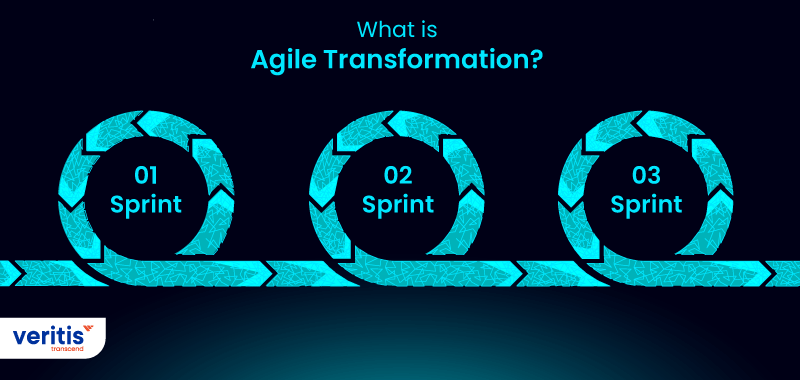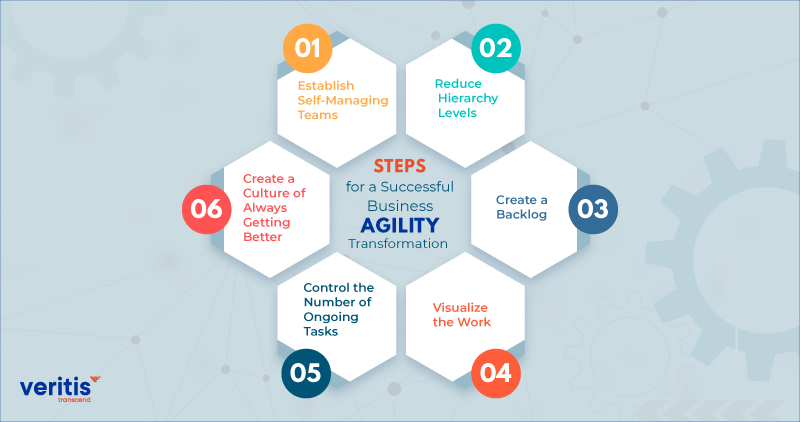
Agile transformation means making a company’s management and development practices more flexible and adaptable, like the agile methodology. This involves changing how teams work together, communicate, and engage with stakeholders. The aim is to make the organization better at responding to changes in the market, customer demands, and technology. This way, they can create and deliver high-quality products and services faster and more efficiently, helping them stay competitive in an uncertain business environment.
Using agile methods in a business allows it to be very flexible, speed up the time it takes to bring products to the market, save money and time, and make employees happier. It makes it easier to grow the business and quickly develop new ideas. When agile is implemented effectively, it ensures that your company is ready for the future.
What is Agile Transformation?

Agile transformation means shifting the whole organization to a flexible and responsive approach based on agile principles. It’s essential to know what it isn’t to grasp agile transformation: just adopting agile methods for software development.
While organizations undergoing this change might adopt agile practices like Scrum or Lean, the transformation is much more significant than changing how software is made.
It’s a complete makeover of the organization, extending beyond just making products. The aim is to refresh the organization by creating a culture that encourages creativity, empowers employees, and reduces unnecessary management layers.
The result could involve teams working together, a stronger focus on satisfying customers, fewer processes and more action, and better communication and sharing of information within the organization.
What is Business Agility?
Business agility is a way of managing that helps organizations grow and thrive by quickly adapting to changes and seizing opportunities with intelligent and efficient methods.
The agile business model started in IT to simplify big projects by dividing them into smaller parts to deliver software faster and more reliably. Over time, it became popular outside IT, especially in marketing, where they adjusted the agile principles to suit their needs.
Agile is becoming popular in departments like sales, finance, and HR. According to the 5th State of Agile Marketing Report, 33% of sales, 20% of finance, and 16% of HR teams use agile practices. The report also found that agile teams prefer working with other agile teams. This is driving adoption of an agile transformation strategy in these adjacent departments.
Simply put, the more agile a company is, the happier its teams tend to be. Agility allows individuals, teams, and companies to be creative, try new things, meet customers’ demands, and adjust to market changes. This helps organizations stay competitive and up-to-date by making their processes more efficient, delivering things more often with fewer resources, being flexible, and concentrating on the value they bring.
Useful link: 8 Best Business Continuity Management Software Solutions
What Are the Reasons for Organizations to Pursue Agile Transformation?

Due to the constantly changing market conditions (VUCA – volatility, uncertainty, complexity, and ambiguity), companies can no longer stick to their old ways for years. They must update their processes to tackle business challenges and stay meaningful and relevant. Here are the main reasons why organizations need to undergo an agile digital transformation:
1) Evolving Market Conditions
In today’s fast-changing business world, companies must be able to adapt quickly. Agile business model methods help them do that by using shorter development and release cycles, getting feedback more often, and reflecting on their progress regularly. This allows them to respond better to market changes and customer needs.
2) Improved Synchronization With Business Objectives
Agile methodologies prioritize delivering value to customers and aligning with business goals, making it easier for companies to achieve their strategic objectives. By focusing on customer needs and preferences, agile teams ensure that products and services meet market demands, leading to higher customer satisfaction. The close collaboration between teams and stakeholders ensures that efforts are directed towards shared organizational goals, improving the company’s overall success and adaptability in a dynamic market environment.
3) Higher Customer Satisfaction
Companies face growing pressure to create products and services that match customer demands. As the market changes quickly, customer needs keep evolving, and products become outdated faster. Agile methods tackle this by involving customers and getting their feedback. This way, companies can adapt to the rapidly changing world and build products and services that meet customer requirements.
4) Improved Collaboration
As organizations get more complicated with changing demands, advanced technologies, and distributed teams, the need for better collaboration and communication between different teams and departments increases. Agile business model methods encourage teams to work together, communicate effectively, and solve problems efficiently, leading to better coordination and alignment.
5) Enhanced Quality
To stay competitive, companies must provide excellent products and agile services. Agile methods support continuous testing and improvement, which helps deliver high-quality offerings. By involving quality assurance teams early in the development process, companies can detect and fix bugs faster, ensuring a better final product.
6) Shortening the Feedback Loop
Agile methods encourage delivering smaller, functional parts of software more often. This allows teams to test and validate the product’s goals and adjust if necessary. It leads to faster learning and adaptability in a rapidly changing market environment.
7) Faster Value Realization
Agile allows companies to deliver products and services in smaller increments, which speeds up the development process and gets them to market faster, delivering value to users quickly. This iterative approach enables companies to gather feedback early and make improvements based on user input, leading to more successful and customer-centric products.
Useful link: 7 Important Types of Agile Methodologies
How to Plan Your Agile Transformation?
Before starting an agile transformation, it’s crucial to understand where your organization stands and what you want to achieve. Here are the steps to follow in your agile transformation roadmap journey:
1) Knowing Your Existing State
The first step to begin an agile transformation is to evaluate your organization’s current situation. This involves examining the existing processes, structures, culture, and technology to identify strengths and weaknesses. It’s called the “As-Is Agility Health Assessment.”
2) Know Your Goals for the Transformation
After assessing the current situation, the next step is determining what you want to achieve with the agile transformation roadmap. This involves setting clear goals and objectives for the transformation and outlining the desired improvements in processes, structures, culture, and technology.
3) Getting Stakeholders on Board and Informed
Involving key stakeholders is essential for a successful agile digital transformation. This means including executives, managers, team leaders, and employees in the planning to gain support and ensure everyone is working towards common goals.
Identify the teams and processes involved: The next step is to understand the interdependencies between teams and processes and determine which ones will be impacted by the agile transformation.
4) Create a Comprehensive Agile Implementation Roadmap
After identifying the teams and processes, the next step is to create a detailed plan for agile implementation. This plan includes setting a timeline for the transformation, determining the necessary resources, and establishing a budget.
5) Set Up a Governance Structure
Creating a governance structure is vital for effectively managing the agile transformation. This involves clarifying the roles and responsibilities of key stakeholders, forming a governance committee, and setting up transparent decision-making processes.
6) Communicate the Plan and Get the Team Onboard
Once the plan is ready, the next step is to share it with the organization. They communicate the transformation’s goals, timeline, and resource requirements to the team members and other stakeholders.
7) Provide Training and Coaching
Training and coaching are essential in an agile transformation. This involves teaching teams about agile methods and guiding them on using agile best practices effectively in their work.
8) Adopt and Monitor
The next step is to start the agile solutions, making the changes and monitoring progress. This includes regular meetings with teams to check if everything is going well and make any needed adjustments as we go along.
9) Continuously Track and Seek Enhancements
Agile transformations are continuous processes that need constant improvement. This means regularly checking the organization’s processes, structures, and culture to find areas that can be made better and making necessary changes.
Useful link: DevOps Adoption and Transformation: Approach, Best Practices and Business Benefits!
Steps for a Successful Business Agility Transformation

Regardless of your industry, agile principles will likely play a more significant role in your work soon. To get ready, here are six terms you can do now to start adopting the agile mindset.
1) Establish Self-Managing Teams
Business agility relies on empowered, self-organizing teams with the freedom to make decisions, take risks, and be accountable for their actions. This approach allows upper management to focus on strategic matters rather than micromanagement. Agile teams can be functional or cross-functional, combining diverse expertise or specific skill sets. Both types have their place in an agile organization. Functional teams can act as shared agile services, streamlining operations for multiple units. Collaborating and applying agile best practices, these teams efficiently create high-quality products, improving workflow processes and generating more value.
Starting small with one cross-functional team as an experiment is a wise approach to embracing agile. Whether implementing it across departments or one team at a time, agile solutions enhance an organization’s adaptability and speed in delivering value to clients. This transformation fosters collaboration and agility, positioning the organization for success in an ever-changing business landscape.
2) Reduce Hierarchy Levels
Big companies like Spotify, Amazon, and Google have tried and embraced the agile way of doing things. They’ve become famous for changing their top-down structure to a flatter one, a process called “delayering.” Instead of being like a pyramid with bosses on top, a flat organization is more like a team where leaders and teams collaborate for common goals.
In a flat structure, there aren’t many levels of management between bosses and employees. This structure has several benefits, such as being more adaptable to changes because of fewer control layers. It also makes employees more responsible for their work.
3) Create a Backlog
Your backlog also called a ” queue,” is a strictly ordered list of all the tasks you and your team aim to complete in the next three months. This helps you identify the most essential tasks and avoid unexpected work requests that don’t fit your current workload.
4) Visualize the Work
No matter your method, making things visible is very important in agile implementation and managing work. This keeps everyone informed about what needs to be done and when.
When work is visualized, teams can see how they use their time, find places where the process is slow, do less work at once, and concentrate more on quality and value. The Kanban board is a standard visualization tool in agile implementation, which helps organizations pick the essential tasks and limit how much work they do at once.
5) Control the Number of Ongoing Tasks
Work in Progress (WIP) limits serve as guidelines to prevent us from starting too many projects simultaneously. The idea is to focus on what we have ongoing, complete it, and then take on something new.
Marketers often take on too much work, simultaneously causing numerous projects to be in progress. This leads to longer project times due to frequent switching. Setting reasonable limits on the amount of work you handle is crucial. This boosts productivity, value, and satisfaction among customers and stakeholders.
6) Create a Culture of Always Getting Better
Create a culture that constantly seeks ways to improve and develop new ideas. During a business agility transformation, staying committed to keeping up with changes in the market and meeting customer expectations through constant adjustments and enhancements is crucial.
As you progress with your agile journey, ensure you can track your progress. This way, you can make decisions based on data that help your business advance.
Useful link: Future of DevOps: Top DevOps Trends in 2023 and Beyond
Conclusion
Changing how a business works to become more agile takes effort and commitment. But if everyone works together to change thinking and culture, organizations can enjoy the benefits of a thriving agile environment in every part of their company.
We expect that more and more parts of businesses will adopt business agility in the future. So, don’t let your organization get left behind. Everything suggests that business agility will become the new usual way of working. No matter the challenges or chances in the market, if you use agile practices across your organization, you will likely stay competitive and do well.
Veritis, the Stevie Award winner, accelerates your journey toward agile transformation. With a dedicated approach, businesses can reshape their operations to be flexible, responsive, and successful in today’s dynamic landscape. Veritis guides your agile transformation strategy, helping you embrace a future where adaptability becomes a cornerstone of thriving, ensuring your organization remains relevant and resilient in the face of change.
Got Questions? Schedule A Call
Also Read:
- 10 Factors That Can Drive Your ‘Digital Transformation’ Initiatives!
- Top 5 Tech Trends CIOs Must Focus on for 2023
- Building a High-Performing DevOps Culture: Strategies and Best Practices for CEOs and CTOs
- AIOPS Solutions: Enhancing DevOps with Intelligent Automation for Optimized IT Operations
- DevSecOps Implemention : Enhancing Security for an Energy Services Firm
- How Agile and IT Service Management can Work Together?